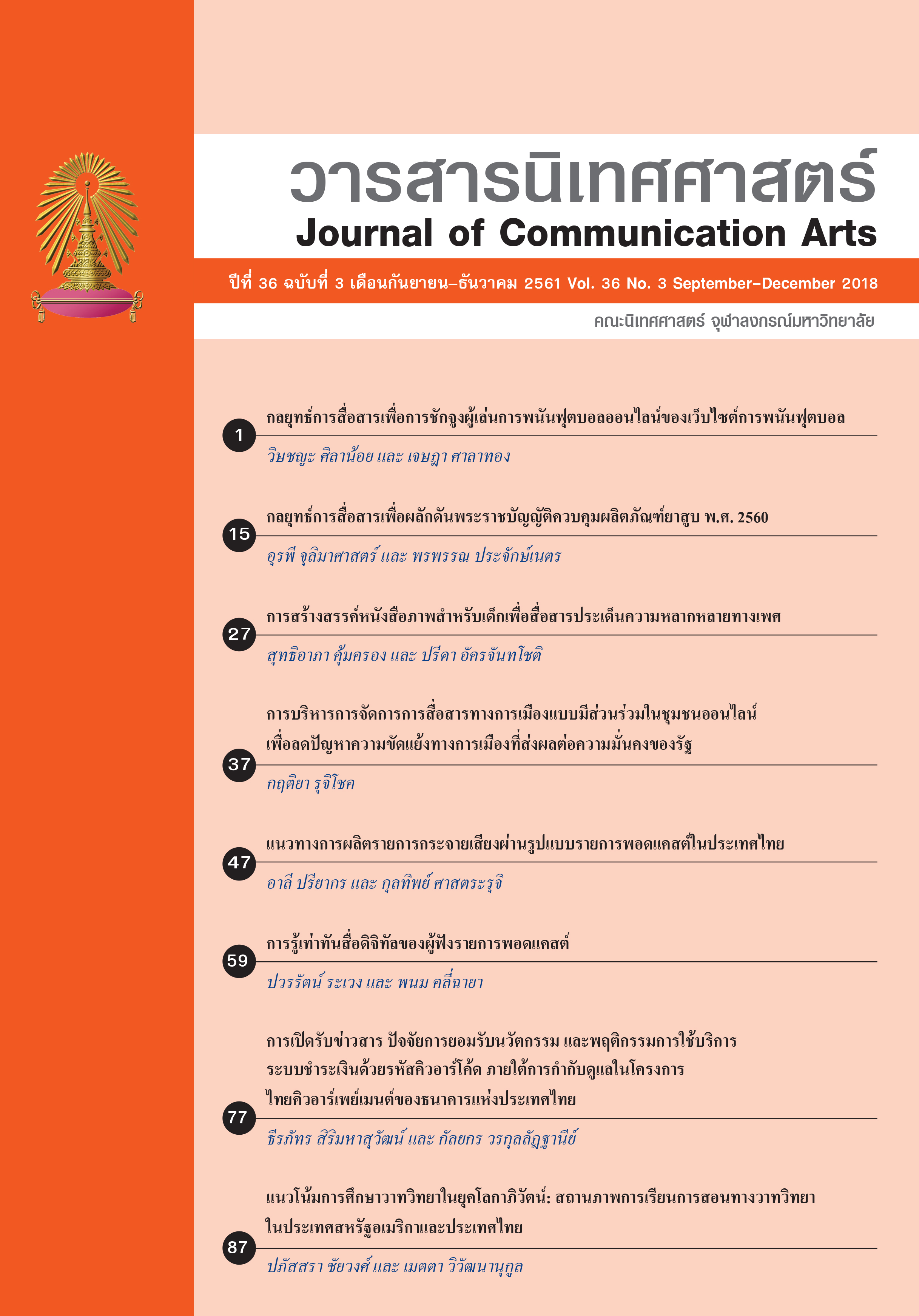แนวโน้มการศึกษาวาทวิทยาในยุคโลกาภิวัตน์: สถานภาพการเรียนการสอนทางวาทวิทยา ในประเทศสหรัฐอเมริกาและประเทศไทย
Main Article Content
Abstract
This article is a part of research entitled ‘Trend of Speech Communication Education in the Era of Globalization’, and was mainly purposed to study the status of Speech Communication curricular and instruction in the USA and Thailandso as to find trend of Speech Communication education in Thailand. Multi-methodology was employed. Documentary study (including websites), quantitative content analysis, in-depth interviews with Thai and foreign scholars and curriculum executives in Communication and Speech Communication were conducted.
The results indicated that due to different history and background, the recognition and understanding relating toSpeech Communication in Thailand were limited and were not as popular as inthe USA. For instance, Speech Communication education in the USA has been long-established (more than 100 years)in a number of well-known universities; whereas in Thailand, there is only one department (Department of Speech Communication and Performing Arts, Chulalongkorn University), andhas been established for less than 40 years.Although the results from the documentary study revealed that universities in the USA had adapted themselves continually in several ways in response to many changes, the findings from the content analysis showed thatthe subjectsin the courses were still strongly focused on Human Communication, Rhetoric and Speech Studies. In contrast, it was found that Communication schools or faculties in Thailandoffered only few courses in Speech Communication area, most of which were applied rather than fundamental courses or core knowledge inHuman Communication.
Article Details
References
จำนง วิบูลย์ศรี. (2544). รายงานการวิจัยเรื่องแนวโน้มการพัฒนาการเรียนการสอนด้านนิเทศศาสตร์สาขาวาทวิทยาระดับอุดมศึกษาในประเทศไทยในทศวรรษหน้า. กรุงเทพ: จุฬาลงกรณ์มหาวิทยาลัย.
เมตตา วิวัฒนานุกูล, ปภัสสรา ชัยวงศ์, Daradirek Ekachai และ Nittaya Campbell. (2560). รายงานการวิจัยเรื่องแนวโน้มการศึกษาวาทวิทยาในยุคโลกาภิวัตน์. กรุงเทพ: คณะนิเทศศาสตร์ จุฬาลงกรณ์มหาวิทยาลัย.
อรวรรณ ปิลันธน์โอวาท. (2547). วิวัฒน์วาทวิทยาสมัยใหม่ในประวัติศาสตร์ไทย. กรุงเทพฯ: สำนักพิมพ์แห่งจุฬาลงกรณ์มหาวิทยาลัย.
อรวรรณ ปิลันธน์โอวาท. (2550). หลักปรัชญาวาทวิทยา. กรุงเทพฯ: สำนักพิมพ์แห่งจุฬาลงกรณ์มหาวิทยาลัย.
อรวรรณ ปิลันธน์โอวาท และ ถิรนันท์ อนวัชศิริวงศ์. (2531). รายงานวิจัยเรื่องการเรียนการสอนวาทวิทยาและการประกอบอาชีพ. กรุงเทพฯ: คณะนิเทศศาสตร์ จุฬาลงกรณ์มหาวิทยาลัย.
อุบลรัตน์ ศิริยุวศักดิ์. (2527). การศึกษาด้านนิเทศศาสตร์ (ระดับอุดมศึกษา) ในประเทศไทย : รายงานผลการวิจัย. กรุงเทพฯ : คณะนิเทศศาสตร์ จุฬาลงกรณ์มหาวิทยาลัย.
ภาษาอังกฤษ
Brummett, Barry. (1994). Rhetoric in Popular Culture. New York: St. Martin’s Press.
Clavier, David., Clevenger, Theodore., Khair, Susan .E., and Khair, Marwan M. (1979) “Twelve-Year Employment Trends for Speech Communication Graduates” Journal of Communication Education. Vol 28, issue 4,
Cohen, Herman. (1994). The History of Speech Communication: The Emergence of a Discipline: 1941-1945. Annandale, VA: Speech Communication Association.
Craig, Robert T., and Carlone, David A. (1998). “Growth and Transformation of Communication Studies in U.S. Higher Education: Towards Reinterpretation”, Communication Education, 47, 67-81.
Engleberg, Isa N., Emanuel, Richard C., Van Horn, Tasha, and Bodary, David L. (2008).“Communication Education in U.S. Community Colleges” Communication Education. Vol. 53, No. 2, April 2008, 241-265.
Gehrke, Pat J., and Keith, William M. (eds). (2015). A Century of Communication: the Unfinished Conversation. New York: Routledge.
Golden, J. L., Berquist, G. F., & Coleman, W. E. (1997). The rhetoric of western thought. Dubuque, Iowa: Kendal/Hunt.
Gronbeck, Bruce E. (1998). Paradigms of Speech Communication Studies: Looking Back Toward the Future. Boston: Allyn and Bacon.
Keith, William M. (2009). “The Speech Tradition”, In William E. Eadie (ed.) 21st Century Communication: A Reference Handbook. (pp 22-30). Los Angeles: Sage.
King, Sarah S. (ed). (1989). Human Communication as a Field of Study: Selected Contemporary Views. Albany, New York: State University of New York Press.
Leff G. and North J. (1992).“Chapter 10: The Faculty of Arts”, in W. Ruegg (ed.) A History of the University in Europe, Volume I: Universities in the Middle Ages. Cambridge University Press.
Littlejohn, Stephen. (1996). Theories of Human Communication (5thed). Belmont, CA: Wadsworth Publishing Company.
Littlejohn, S., & Foss, K. (2011). Theories of human communication (10th ed.). Long Grove, Ill.: Waveland Press
McBath, James and Jeffrey, Robert C. (1978). “Defining Speech Communication”, Communication Education. 27(3) (September, 1978), p. 181-188.
Morreale, Sherwyn P., Osborn, Michael M., and Pearson, July C. (2000). “Why Communication is Important: A Rationale for the Centrality of the Study of Communication”. Journal of the Association for Communication Administration. 29 (2000), 1-25.
Muir, Janette Kenner. (ed) (2011). Coming to Terms: The Collected Works of Jane Blankenship. Lexington Books.
Packer, Jeremy. (2006). “Rethinking Dependency: New Relations with Transportation and Communication” in Jeremy Packer, and Craig Robertson (eds) . Thinking with James Carey: Essays on Communications, Transportation, History. (pp 79-100) New York: Peter Lang.
Peterson. (2011). The Graduate Programs in the Humanities, Arts, and Social Sciences: Sections 15-27 of 27. Lawrenceville, NJ: Peterson’s Publishing.
Rogers, Everett M. (2001). “The Department of Communication at Michigan State University as a Seed Institution for Communication Study”, Communication Studies, 52:3, 234-248
Wood, Julia T., and Gregg, Richard B. (1995). Toward the 21st Century: the Future of Speech Communication. Cresskill, NJ: Hampton Press.

